Index | Playable Races | Monsters (Humanoids | Monstrous Humanoids | Animals | Vermin | Magical Beasts | Plants | Fey | Dragons | Aberrations | Constructs | Oozes | Undead | Outsiders)
Characters in Starfinder come in a myriad of forms. A character's race determines a number of additional factors that influence how they play on the tabletop, from mechanical factors representing their unique biology to roleplaying opportunities resulting from their native culture. For tropes that applied to these races in Pathfinder, see either Pathfinder Playable Races, Pathfinder Humanoids, Pathfinder Monstrous Humanoids or Pathfinder Aberrations.
- Ascended Extra: In Pathfinder, androids and kasathas only have a presence in Numeria (where the Divinity crashed millennia ago), lashuntas usually only appear in adventures that are set in Numeria or leave Golarion for their native Castrovel, while ratfolk are spread out and never found in large numbers anywhere; all four have since become core species in Starfinder. Averted with humans, who are core in both games, and vesk and shirrens, who were created for Starfinder.
- Demoted to Extra: With Golarion's disappearance, all non-human core species in Pathfinder have declined in prominence.
- Massive Race Selection: The 'cantina feel' is important to Starfinder. Paizo has stated that they want players to have access to a wide array of species to create characters with.
Core Races

Made from equal parts machinery and biology, androids were once a servitor race before breaking free to form their own society. Unlike other creations, androids have souls, a distinction that plays a large role in distinguishing them as sentient.
- Artificial Human: Their most notable trait. The differences between them and normal humans is Androids are often depicted as unusually pale (almost white), with unnatural hair colors and Tron Lines on them.
- Discard and Draw: Starfinder androids don't have the Nanite Surge ability of the Androffan/Numerian androids of the past. Instead, they have a built-in armor upgrade slot. However, the Character Operations Manual offers a variant choice that replaces the slot with the classic Nanite Surge again.
- Mechanical Lifeforms: Androids are Ridiculously Human Robots, "bleed" watery coolant and even have souls. There are multiple times that reinforce that Androids are purely synthetic Artificial Humans, but respond to healing magic and have souls as organic creatures do. They breathe and eat much as humans do, but through artificial organs, and they circulate their healing nanites like blood through their bodies via pale fluids. They are inexhaustible, immune to diseases and resistant to other biological effects, and fortified against mental effects, but also suffer the same maladies and vulnerabilities of constructs and are susceptible to supernatural curses, including lycanthropy.
- The Nth Doctor: Inverted, the same body is host to a succession of different people.
- Reincarnation: Inverted. When an android has lived what it feels is a full enough life, it triggers it's nanites into an accelerated repair mode that fixes the body just like new, but their soul will leave the body for the Boneyard and a brand new soul will come to inhabit it. They call this "Renewal", and consider it a form of procreation.
- Ridiculously Human Robots: They can generally pass as human despite "awkward mannerisms" (though some do go for more obvious mechanical features), but bleed watery coolant. Moreover, they actually have souls.
- Slave Race: What they originally were, and what some places still use them as.
- Tron Lines: These cover their bodies, though they can be more or less obvious depending on how much energy their systems need to be channeling at a given time.
- Who Wants to Live Forever?: Androids are functionally immortal as long as they have proper maintenance, but most will willingly undergo Renewal after around a century.

Originating from Golarion and Akiton, humans have since taken to Absalom Station as their homeworld following the Gap. An ambitious and creative race, they are often viewed as brash and reckless by others.
- Amazing Technicolor Population: Akitonian humans have red skin.
- Heavyworlder: Humans adapted to a high-gravity world develop thick musculature over sturdier forms.
- Humans Are Average: They don't have any eye grabbing special abilities, just a general proficiency in most things.
- Humans Are Not the Dominant Species: Humans can be found on nearly every planet in the solar system, either integrated into alien societies or creating colonies and homesteads on new worlds, and have shown more drive to explore their system and the universe beyond than most other species. On the other hand, humans were one of the species hit hardest by the Gap, due to the disappearance of their homeworld Golarion.
- Human Subspecies: The hylki of Akiton, who immigrated from Golarion many millennia before Pathfinder, have literally red skin but statistically are no different from the average Golarion human.
- Jack of All Stats: Humans' versatile racial bonuses lend them well to every class — though there are some cases where specific races have special class synergies that top humans.
- Lightworlder: Humans born and raised in low- or zero-gravity conditions sometimes develop differently. They are usually taller and longer-limbed than normal, with less muscle mass.

Four-armed natives of a distant, desert world, the kasathas fled their home as their star neared collapse and arrived in the Pact Worlds in the generation ship Idari.
- Doomed Hometown: Their homeworld of Kasath is dying, and the kasatha are trying to carve out a new life in the Pact Worlds as immigrants.
- The Faceless: There has never been an image of a kasatha that's shown its lower face, with every one of them hiding it with a scarf, mask, or other item of clothing. Covering one's lower face is a tradition that extends millennia in the past, but no one quite knows the origin of it. For the curious, an image of a kasatha skeleton
 ◊ in Pathfinder shows a fairly human-like jaw.
◊ in Pathfinder shows a fairly human-like jaw. - Generation Ship: The Idari, a slower-than-light colony ship originally sent from Kasath to colonize Akiton. Most of the Kasatha in the Pact Worlds were either born on the Idari, or are second-generation of immigrants who arrived on it.
- Good Old Ways: Respect for tradition is considered a high virtue in Kasatha culture, inclining many of them to hold to ancient ways and the study of history. They're regarded by others as being a combination of hidebound and aloof, but also very knowlable.
- Multi-Armed and Dangerous: They have four arms, though with Starfinder's changes to how many attacks you can make this just gives them more flexibility, such as being able to use a rifle while still having hands free for backup weapons or the like, or taking extra advantage of feats that require free hands to employ.
- Named After Their Planet: The kasatha came from the planet of Kasath; it is unknown whether the planet was named after the race or vice versa.
- Our Nudity Is Different: Kasatha modesty requires that the mouth be covered around all but the most intimate companions.

Natives of Castrovel, lashuntas are separated into two subspecies, the bulky and muscular korasha and the lithe and graceful damaya, with each lashunta starting out as indeterminate at birth and developing into one or the other subspecies as a response to environmental factors or as a conscious choice aided by medications and meditation. Both subspecies have innate psychic powers useful for self defense and communication.
- Amazonian Beauty: The korasha lashunta are a bit short for this trope, but being stout and well muscled doesn't take away from their attractiveness, as the book mentions.
- Arch-Enemy: They've warred with the formian hives of their homeworld for thousands of years, with peace having only been declared within the last few decades.
- Fantastic Racism: While the lashunta normally pride themselves on being cosmopolitan and accepting, their long, long, long history of war with the formians has left them suspicious of other insectoid races, with many extending that to the shirren, wondering how long it will be before the "bugs" turn on them.
- Green-Skinned Space Babe:
- Damaya lashuntas look like idealized humans or elves (of both genders, admittedly — male damaya share these traits in full), are renowned for their beauty, and live on a hot planet that is most comfortable in minimal clothing. Subtle.
- Korasha lashuntas are downplayed versions; they're not quite as idealized, but they're still more than ruggedly handsome enough to qualify for the Charisma bonus.
- Progressively Prettier: The korasha in Pathfinder were noted to be ugly, while in Starfinder they're more ruggedly handsome.
- Proud Scholar Race: Lashunta are drawn to scholarly and magical pursuits and gain a bonus to Intelligence.
- Proud Warrior Race: Korasha are drawn to physical and martial careers and have a Constitution bonus.
- Psychic Powers: They have minor telepathic abilities, which they can learn to amplify to aid their allies and Bond Creatures, and their home planet is renowned for its psychics.
- Rubber-Forehead Aliens: Their most alien feature is their antennae. Other than that, they look just like elegant and beautiful (if damaya) or stout and muscular (if korasha) humans.
- Space Elves: Damaya lashuntas are tall, willowy and graceful humanoids with a pair of small antennae, are known for their ancient and scholarly civilization and have an affinity for both magic and psychic powers. The korasha, by contrast, are more akin to Space Dwarves, being short, stout and muscular, although they still have the telepathy and antennae.
- Tamer and Chaster: While still very attractive and often wearing flattering clothing, the fact that they wear proper clothing at all is more modest than their portrayal in Pathfinder 1st Edition.
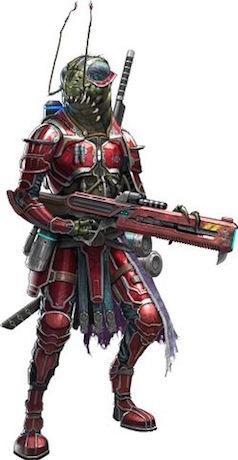
Members of a rogue subhive of the Swarm, shirrens are insectoid beings foreign to the Pact Worlds.
- Bizarre Alien Sexes: Shirrens have three sexes; Male, Female, and Host. Hosts, as their designation suggests, actually carry the fertilized egg to term, and also contribute their own DNA to the child in the process.
- Horde of Alien Locusts: They originated as a sub-hive of one such Horde, the Swarm, until a mutation granted them sapience and free will. Once they had the ability to control their own lives, the Shirren chose to reject the Swarm's life of mindless, constant and aggressive consumption, and decided to try living alongside other lifeforms instead of eating them.
- I Just Want to Be Special: Downplayed, the same mutation that broke them from the Swarm's Hive Mind makes them almost compulsively fascinated by self-expression. A Shirren spends their life looking for new ways to distinguish themselves as individuals, finding joy in simple expressions of personal decisions.
- Insectoid Aliens: They resemble large, bipedal locusts. They have six limbs — two legs, two large arms and two smaller arms — but they keep their smaller pair hidden away most of the time: in their culture, the smaller arms (usually called the "mating arms") are only supposed to be used during reproduction, and are not to be used or revealed for any other reason. They used to be part of a Hive Mind as well, but they long since broke away from it, only retaining a mild form of telepathy from it.
- My Species Doth Protest Too Much: They used to be part of the Swarm, a Hive Minded Horde of Alien Locusts. They broke away and developed individuality due to a mutation. They defected from her rest of the Swarm, choosing to live as their own beings and to try to coexist peacefully with other races, rather than mindlessly destroying and consuming everything they found.
- Our Nudity Is Different: Their main physical taboo relates to their smaller second and third pairs of arms. They're only supposed to be used in mating and in certain ceremonial situations, and using these arms for any other purpose is considered obscene and taboo.
- Rogue Drone: They were once part of the Swarm, a roving predatory Hive Mind. They developed independent consciousness due to mutation, and afterwards abandoned the Swarm to live their own lives as free beings.
- Telepathy: One feature they did retain from their old Hive Mind is a mild ability to sense other beings' thoughts and emotions, a weakened derivative of the Swarm's shared consciousness.
- The Unpronounceable: Because of their insectile physiology, shirren names can sometimes be harsh and awkward for members of other races to pronounce. They readily accept nicknames bestowed by members of other races.

Burly reptilians from the Veskarium, a warrior civilization originating in a nearby star system.
- Asskicking Leads to Leadership: While there are Vesk who occupy all walks of life, political power within the Veskarium is limited to those who demonstrate martial skill. Many young Vesk who aspire to influence go on errant journeys to demonstrate their prowess, while those seeking influence outside of those martial traditions often travel outside the Veskarium to find their fortunes.
- Enemy Mine: The Veskarium and the Pact Worlds first interacted through open war, and later coexisted in an tense cold war for several centuries. By the game's present, they've been forced into an uneasy alliance in order to face the rising threats of the Swarm and the Azlanti Star Empire, which neither would be able to face alone.
- The Empire: The Vesk are the ruling population of an empire encompassing a single system, imposed from one inhabited world upon all the others within that system, and were posed to expand before the Pact Worlds fought them to a standstill and the coming of the Swarm forced them into an alliance together.
- I Gave My Word: Vesk have a strong sense of honour and pride in fulfilling their agreements.
- Klingon Scientists Get No Respect: The vesk, by and large, prefer to be in combat or serving on the frontlines, to the point that most of the bureaucracy of the Veskarium is occupied by the Skittermanders.
- Lizard Folk: Starfinder's primary race of reptilian aliens. Appearance-wise, they resemble burly humans with scaly skin, clawed fingertips and reptilian heads and tails. They also come in a range of colors, mostly blue and green. Personality-wise, they're highly aggressive and expansionistic warriors, with the main concern of their civilization being warring against and subjugating all other species they meet.
- Proud Warrior Race: The vesk come from an empire known as the Veskarium, a warlike civilization focused on martial values and military expansion. They swiftly conquered their entire star system after achieving space travel, and their first reaction to obtaining Drift technology from the Pact Worlds was to use it to launch a full-scale invasion of the same in an attempt to conquer the Pact Worlds too.

Small rat-like beings known for wit and technological skill. Their homeworld is unknown, as ratmen have been found on several worlds before spaceflight was possible.
- The Nicknamer: Nicknames are often as important to ysoki as their actual names, and they tend to give both other ysoki and their non-ysoki friends monikers that refer to their personality or physiology.
- Rat People: They resemble small, bipedal rats.
- Tertiary Sexual Characteristics: You can tell the females in the artwork mostly by their long eyelashes. Their apparent androgyny is actually noted in the text.
Golarian Races
These former core species of Pathfinder are still around now, and often still have important roles in the Pact Worlds.
A short, stocky, long-lived race, dwarves heavily value tradition. One of the most prominent traditions is the Quest for the Sky, and while some believe it fulfilled long ago when their ancestors reached Golarion's surface, others feel it will not be complete until they find a new sky, a homeworld for themselves. They are largely concentrated in Absalom Station or on dwarven star citadels.
- Good Old Ways: With long lives and strong traditions, dwarves are very slow to change their way of life.
- Long-Lived: They can live several hundred years before dying of old age.
- Our Dwarves Are All the Same: Very standard dwarves that are short, stocky, conservative and traditionalist, live in a clan-based society and have an affinity for mining and technology. They no longer live underground though, as Golarion is gone.
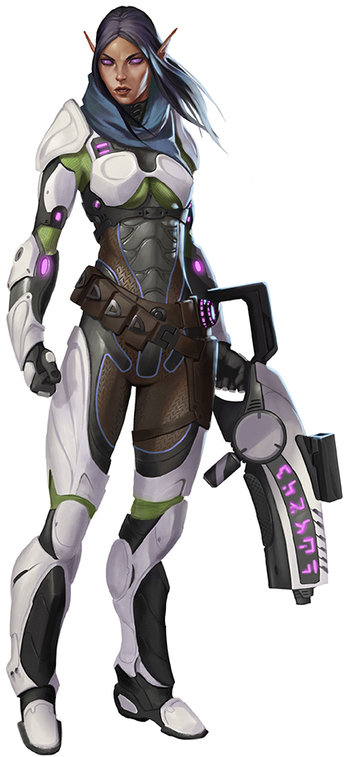
Elegant humanoids with a long lifespan, the Gap hit them harder than most. With vast swaths of their population missing the majority of their memories, many elves became convinced that they had been betrayed during the Gap. Unable to determine who the guilty party could be, if there even was one, the elves withdrew to Sovyrian on Castrovel and rapidly developed into a reclusive and xenophobic society. Elves deeply value magic as the continuation of their ancestors' work and many of the elves seen outside their own kind are seeking fragments of lore or magical items.
- Hidden Elf Village: Following the Gap, elves have mostly retreated to their ancestral homeland of Sovyrian in Castrovel and isolated themselves from the rest of the universe.
- Long-Lived: Even more so than dwarves, with lifespans capping out near a thousand years. Yes, this means that many Elves lived though the Gap, and they are not happy about that.
- Our Elves Are Different: Elves are still the same lithe, long-lived, whimsical and passionate race of humanoids with characteristic pointed ears that live in relative isolation with other races. They were also the hardest-hit race by the Gap, and have grown xenophobic as a result of that.
- Pointy Ears: Pointed ears are a trademark of elves that set them out from humans.
- Rubber-Forehead Aliens: They're native to Castrovel and look like humans with pointed ears.
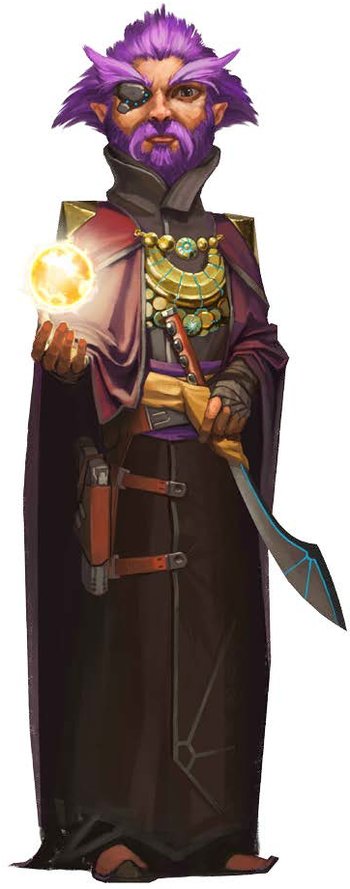
Emigrants first of the First World, then of Golarion, Gnomes are a varied people. There are two ethnicities of gnome. Feychildren have wildly colored hair and skin, but are forced to constantly seek new experiences to maintain their vibrancy or else undergo the Bleaching. Bleachlings are descendants of those who survived the process, lacking the wild personalities and appearances of their feychildren kin. Gnomes are also the only outside race welcomed by the elves of Castrovel for reasons unknown.

Interracial children of elves and humans. With no one heritage, they often feel like outsiders and band together with others who feel the same way or those to whom humans and elves are so alien they wouldn't realize something was strange. Half-elves are welcomed in Sovyrian, though they are considered second-class citizens, and Absalom Station takes them as readily as it does any other.
- Half-Human Hybrid: The vast majority of half-elves are half-human on the other side, to the point that they have both the elf and human subtypes.
- Non-Human Humanoid Hybrid: A growing number of half-elves on Triaxus are half-ryphorian instead of half-human. They are oddly similar to their human-born counterparts, however.
- True-Breeding Hybrid: It's not particularly common, but half-elves breed true and a number of half-elven settlements have sprung up around the Pact Worlds. The result is that some half-elves are quite far removed from their human, elven or ryphorian ancestors.

Interracial children of orcs and humans. Generally shunned by society, most half-orc either seek positions where the fear they cause is an asset, group with others shunned by society, or push beyond society to break ground for colonies.
- Determinator: They can keep going for one round after being brought below zero hitpoints.
- Half-Human Hybrid: Half human, half orc. However, since it's mentioned that because orcs were almost entirely contained to Golarion and Golarion is gone, most half-orcs since the Gap have been the result of true-breeding between other half-orcs.
- Slave Race: Not technically but for all practical purposes. The majority of half-orcs and orcs live on Apostae as second class citizens with no say or representation on political matters at all, serving the drow rulers of the planet as manual laborers or mercenaries.
- The Character Operations Manual introduces a variant that actually were slaves under the Drow, and thus have different stat bonuses than freed Half-Orcs.
- True-Breeding Hybrid: Orcs were almost entirely confined to Golarion at the time that it disappeared, making them very rare in the modern Pact Worlds; as a result, most half-orcs now are the result of true-breeding between half-orcs.

A diminutive race known for their even tempers and cool heads. Most halfings eschew enhancements, considering halfling biology to be pretty much perfect already. Though they make good spokesmodels or entertainment stars, a long history of enslavement means few will lock themselves into commitments.
- Born Lucky: As always, they're naturally lucky.
- The Pollyanna: Their cheerful optimism is often kept even when in danger, making them seem fearless in comparison to other races.
- Retired Badass: Halflings are practically genetically predispositioned to become this, most of them having a phase as bold daredevils in young adulthood before mellowing down.
- Slave Race: They've had a history of being such, and distrust many races as a result.
Additional Races
Humanoids
- Beast Man: Alkainans are badger-like humanoids with metallic fur.
- Metal Muncher: Part of an alkainan's physiology depends on the types of metals their ancestors consumed on their original home world, a place of naturally occurring metallic spires.

Anassanois are native to a distant star, Anassan, which they left in a generation ship named the Kahlannal. Anassanois are natural telepaths and extremely open when communicating with telepathy, suffusing such exchanges with the feelings their physical gestures lack. This openness translates into emotional honesty, offering others a ready sense of who the speaking anassanoi is.
- Future Imperfect: The anassanois of the Pact Worlds sun have forgotten about their ancestral homeland, and the fact that the Kahlannal was only one of the ships that fled Anassan, and they might have cousins in distant parts of space.
- The Theocracy: The Protectors are portrayed in anassanoi religion as agents of the god Raethu, and responsible for governing their species.

Natives of Bortan II, a world reduced to an irradiated wasteland during the Gap. They were marginally conquered by the Azlanti Star Empire, with the only city on the planet arising around the empire's single outpost.
- Healing Factor: If a brakim loses a limb or digit, it regrows in hours.
- Running on All Fours: A brakim can modify their arms for locomotion, moving as a quadruped, gaining a bonus to speed but becoming unable to manipulate objects.

Brenneris are a mostly peaceful species that hail from Varturan, a planet in Near Space covered in vast waterways. These 5-foot-tall mammalian humanoids resemble otters, though they have slightly longer legs that allow them to walk upright. Brenneris are particularly adept at detecting subtle physical and emotional reactions. This makes them especially skilled at understanding the emotions of others, and they are naturally talented diplomats.
- Beast Man: These mammalian humanoids resemble otters, with slightly longer legs that allow them to walk upright.
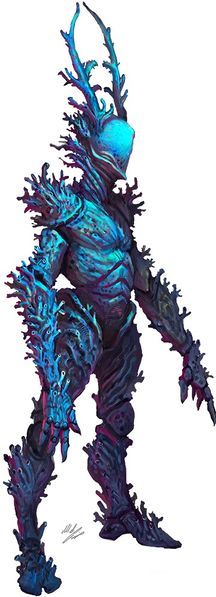
Inhabitants of a dying world, they applied for admission to the Pact Worlds through the Starfinder Society. Whether by fleeing their homeworld or by gaining admittance, they contribute to the galaxy at large.
- Beast Man: They're a collection of papules inhabiting a roughly humanoid coral-like body.

Survivors of a shattered planet, damai are a hardy, if sometimes foolish, people. Only making their way out of their underground bunkers a few decades ago, Damai are ambitious to the stability they once had, though it's a hard going process for them.
- Had to Be Sharp: When you're living on a cracked planet that's ‘’infested’’ with Kaiju, it helps to be able to survive in it. This is represented as a bonus to their Stealth and Survival skills, which is increased if the damai is underground.


Dessamars are humanoid natives of Koshoria, a world bathed in violet magical auras in Azlanti space. While adults resemble bipedal butterflies, dessamars hatch from eggs as tiny larvae that grow as they mature. Azlanti call the larvae “instars,” due to an error in a first-contact report. Instars are sapient, and older larvae are encouraged to explore the world on their own so they can discover their path in life before their metamorphosis into an adult. Once the larvae feel ready, they feast enough to double their size before spinning magical cocoons. About two weeks later, a dessamar adult, called an imago, emerges. Occasionally, instars refuse to transform. Though most dessamars accept older instars, adults often encourage such larvae to seek physical maturity.
- Insectoid Aliens: Dessamar adults resemble bipedal butterflies, while juveniles resemble larvae.
- Non-Indicative Name: Dessamar instars are actually the larvae of their species; the name came into being due to an error in a first-contact report.
- Teleportation: Once per day, a dessamar can teleport 40 feet.

Dirindis are stout humanoids with three eyes and an affinity for humor and electricity. They greet each other with friendly zaps of electricity and outrageous retellings of recent adventures, and visitors to Arkanen are unlikely to avoid some enthusiastic zapping from the locals.
- Shock and Awe: Dirindis have an affinity for electricity, and greet each other (and outsiders) with friendly zaps.

Long ago an amphibious race, the draeliks hail from a now-arid world called Great Shadar. Many follow a religion headed by beings from the negative energy plane, who preach that entropy is the natural order of things. Though they almost exclusively create devices that increase this entropy, often through the use of negative energy, they look down on those who would hurry existence to its final state like children who want to skip to dessert rather than experience the full meal.
- Dark Is Evil: They practice shadow magic and worship the concept of entropy, and lean towards evil alignments.
- Lizard Folk: They look reptilian, though they have some amphibian traits.

The dark cousins of elves, the drow have taken to Apostae as their new homeworld. Dwelling in subterranean caverns, drow have a strictly matriarchal society where families constantly strive to backstab and outmaneuver each other in their constant climb for power.
- Irony: They're actually somewhat more well integrated into Pact Worlds society than baseline elves are, acting as arms dealers and developers, while elves have become far more isolationist. It's mentioned that elven extremists who launch attacks against them are actively condemned by Pact Worlds governments.
- Bizarre Alien Sexes: Elanayas have four sexes.
- Bond Creatures: Most elanayas form a permanent bond with an elemental at adolescence, and can manifest their bonded elemental in their own body.

Sentients native to Eox, most turned to undeath when the backlash from a superweapon decimated their world. A few survived in their normal, living forms.
- My Brain Is Big: Their enlarged craniums signify their advanced intelligence.
- The Necrocracy: Undead elebrians now far outnumber living ones, ruled by the bone sages.
- Rubber-Forehead Aliens: They resemble humans with enlarged craniums.
- Sudden Name Change: The elebrians were originally just called Eoxians after their home planet in Pathfinder, as no one on Golarion knew their racial name, or that they were a distinct race from humans, back then.
- Undead Laborers: The undead elebrians know that they won't age or weaken, there's no concept of retirement, and an elebrian tasked with guarding a wall knows that in 3 centuries, the wall will still be standing and the elebrian capable of doing so.

A race with highly malleable flesh they can reshape to look like other races.
- Covered with Scars: As an endiffian ages, the repeated use of their shapechanging causes cracks and scars on their skin. In endiffian culture, these scars are viewed as evidence for a life full of successfully capitalising on their abilities. Scarred elders are revered for their knowledge and take pride in the breadth and depth of their experiences.
- Voluntary Shapeshifting: Endiffian flesh is incredibly elastic, allowing them to re-form their appearances at a cellular level. They can even modify the shape of individual cells to absorb or reflect visible light, so endiffians can reshape themselves into simulacra of virtually any humanoid.

A race of large, avian humanoids originating from the Near Space planet Neeroon.
- In Harmony with Nature: Espraksa settlements emphasise harmony with nature. They avoid razing the environment to make way for their settlements, instead incorporating their homes high up in the surrounding trees and terrain.
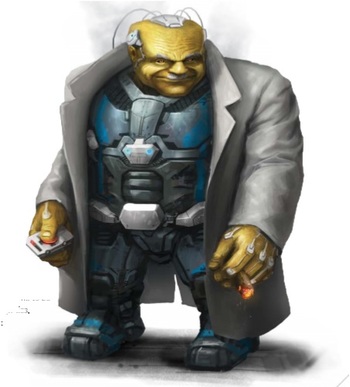
A stout race from a world consumed by a black hole. They now live on their moon, still floating just outside of the event horizon.
- Dying Race: Their planet being consumed by a black hole has put them in a precarious position, and they're currently one natural disaster away from being effectively extinct.
- Heavy Worlder: Ferrans are short, squat humanoids native to a high-gravity world.
- Rubber-Forehead Aliens: They look like stout yellow-skinned humans or, alternatively, yellow dwarves.
Gathols are hulking, hearty natives of Ghaggath, a mountainous planet in the Thenekral system.
- Blood Knight: Gathols are naturally bellicose, and warred with each other for generations before the Azlanti arrived. They then bitterly fought the invaders until an Azlanti general offered them the chance to test their mettle against strong foes across the galaxy.

Ghibranis are beetle-like humanoids native to the planet Elytrio. After the ghibranis devastated their world with nuclear war, some of the survivors fended for themselves in the wastes, while the rest lived comfortably in a city protected by a bubble of force. The lingering radiation (even within the city) caused a rapid change in their biology, leading to two subspecies: husks, who have lost the use of their wings, and membranes, who have grown idle in their luxury.
- After the End: Their homeworld, Elytrio, was devastated by nuclear war, with a portion of the survivors living in a protected dome city while the rest eek out a living in a harsh, radioactive wasteland.
- Insectoid Aliens: They're humanoid beetles.
- Nice Guy: Their Affable trait gives them a racial bonus to diplomacy checks.
- Scam Religion: The husk ghibranis who live outside the domed city of Arkeost do so because hundreds of years ago, the ancestors of the membrane ghibranis told them the goddess Mother Touloo had declared them her chosen people and had a promised land for them in the wasteland. Problem being that Mother Touloo is entirely fictitious, invented for this purpose to save Arkeost from overpopulation. Centuries later, the membrane ghibrani have completely forgotten their own deception.
- Good Old Ways: Giants care deeply for tradition and kin, commemorating their deeds and building bonds through media, tattoos and stories.
- Our Giants Are Bigger: Giants are a varied group of humanoid species of at least Large size. Other than that, all giant subspecies are very different from one other.
- Progressively Prettier: Ports of Call shows a mother Hill Giant and child. While Hill Giants in Dungeons & Dragons and Pathfinder are typically depicted as grossly fat and hideous, the mother is drawn as a Brawn Hilda(at worst), while the child is downright cute.
- Promoted to Playable: Fire, hill, slag and stone giants are the four giant species that made the jump from NPCs in Pathfinder to playable species in Starfinder. The other giant species remain unplayable.

Gnolls are hyena-headed humanoids with a reputation as bloodthirsty raiders, scavengers, and cannibals. They are capable hunters who respect power and strength over station or role, and most gnolls would believe their own survival takes precedence over any kind of morality.
- Heinous Hyena: True to form, gnolls have a well deserved reputation of being nothing more than pirates, thugs and mercenaries with no moral compass to speak of.
- The Nose Knows: They have such a refined sense of smell that they can track even invisible prey near them by scent alone.
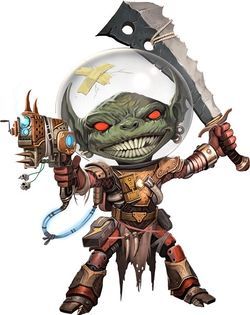
A small and chaotic race, goblins are known for cobbling technology together out of scrap, voraciously consuming anything they can get their hands on, and generally being a pain to deal with.
- Archaic Weapon for an Advanced Age: They still carry the trademark crude cutting weapons of their ancient brethren. And yes, they're still called dogslicers.
- Big Eater: They eat a lot, though not to the same extent as normal goblins.
- Our Goblins Are Different: Pathfinder's standard, borderline suicidally stupid goblins but IN SPACE!.
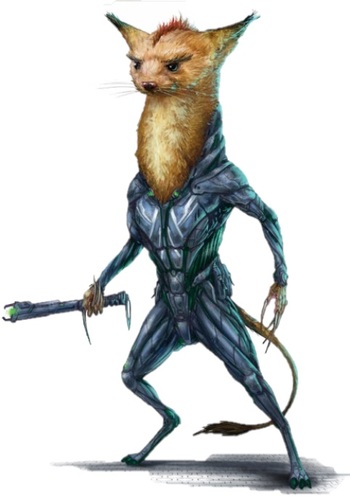
Natives of a volcanic continent on the planet Duren, glosclaws became experts at engineering to build safe subterranean homes. When the Azlanti Star Empire came to them they knew they could not resist and willingly submitted, becoming a citizen race.
- Voluntary Vassal: When the Azlanti Star Empire landed on Duren, the gosclaws knew they could not hope to rebuff such a technologically advanced enemy, and approached the Azlanti with an offer of service and proof of their engineering prowess. Ever since, gosclaws have held citizenship and served the Star Empire diligently, if not with complete loyalty.

An enigmatic race, the few who know of their existence know them as infiltrators and spies. What their end goals are, or if they even have any, are unknown to all but themselves.
- The Grays: They are a malevolent race of alien humanoids with grey skin, long, willowy limbs and a bulbous head with oversized black eyes. They have a habit of abducting people and have infiltrated several societies throughout the Pact Worlds, pursuing complex agendas of manipulation and espionage aimed at goals only they know of.
- Intangible Man: They can phase partially out of reality, making it harder to hit them.
- Laser-Guided Amnesia: They use memory expungers to wipe memories of their actions.
- Mind Rape: They have telepathic abilities they use to this effect.
- The Spook: Very little is known about them or their goals.

Gripplis are small humanoids that resemble brightly colored tree frogs. Gripplis have had access to advanced technology for only a relatively short time, as interstellar trade has transformed their traditional hunting and gathering culture. Gripplis are still rare in the wider galaxy, but more and more of them are embracing modern technology, and they’re eager to explore the galaxy and meet its inhabitants.
- Frog Men: Being essentially antropomorphic frogs, it should come as no surprise that most related tropes apply, including their talent for jumping and an affinity for marshlands and swamps.
- In a Single Bound: Gripplis' powerful legs enable prodigious leaps.

Though now the symbiotic primary inhabitants of the three moons of Hadrogess—a desolate world in the Vast—hadrogaans once lived on the planet itself, millennia ago. From infancy, hadrogaans have a constant internal dialogue between their organic brains and the crystalline neural network inhabiting their body. The crystal pushes them to consider the practicality and utility of every action, as well as that of any person or object they might encounter.
- Crystalline Creature: Kallestrine are crystalline organisms native to Hadrogess' crust. Historically, they developed vast spindle grids that interlaced the bedrock like a mycelial network; currently, small kallestrine shards are inserted into a young hadrogaan's body and develop a lifelong bond with their host.
- The Symbiote: The entire hadrogaan species is merged with kallestrine, a sapient crystal that grants greater intellect and insight. From infancy, hadrogaans have a constant internal dialogue between their organic brains and the crystalline neural network inhabiting their body.

Hobgoblins are a militant and merciless species that organizes quickly, reproduces rapidly, and adapts well to changing conditions. They are similar in appearance to goblins but are significantly taller and more muscled. While goblins are anarchic and gleefully destructive, though, hobgoblins are highly ordered and do nothing without a purpose.
- Fantastic Racism: Downplayed. Due to the Gap some hobgoblin societies no longer have any animosity against the elves, save for those that suffered elven attacks right after the Gap. Most of the race, however, considers Elves to be vile and mistrustful creatures not even fit for slave labor.
- Outgrown Such Silly Superstitions: They used the Gap as an opportunity to re-examine some of their long-held traditions and discard those that didn't make sense, such as the prohibition on magic use.
- Proud Warrior Race: Their societies are virtually all military.

The ikeshti are a reptilian race native to Akiton with an unusual life cycle. Born as little more than ravenous mouths, they develop into an adolescent stage that lasts between one and two decades before entering their adult stage. They become composed to mate and after doing so engage in battle to the death, with the surviving mate settling into the final stage of their life to tend for the young. Those who are unable to secure a mate regress into savage beasts that care for nothing but battle and food.
- Lizard Folk: They're human-sized, bipedal reptiles with rust-red scales.
- Was Once a Man: The riveners are ikeshti who weren't able to mate and had their minds and bodies overwhelmed by a flood of hormones. They're much larger than their still-sentient brethren and care for little more than killing and eating.
As composites of flesh, bone, and moss, kaa-lekis are striking figures that stand 7 feet tall on average. Kaa-lekis are tripodal humanoids with patches of blue-green moss that grow naturally on their skin. The kaa-leki home world is the corpse of a titanic organic crystalline creature called Hawanna, but their legends claim they originated elsewhere. Kaa-lekis have learned to handle the strange and hostile crystal constructs that roam Hawanna’s surface, but the true history of the constructs is lost to the Gap.
- Plant Person: Kaa-lekis are tripodal humanoids with patches of blue-green moss that grow naturally on their skin. In the game, they have the plantlike subtype.
- Bird People: Kevris are avian humanoids with talons, hard parrot-like beaks and large feathered wings.
- Giant Animal Worship: Since the dawn of their civilisation, kevris have worshipped the ararak, Kevlo's apex predators, as living gods.
- Human Sacrifice: One traditional kevri rite is to sacrifice losers in gladiatorical combat to ararak.

Plantlike humanoids, the solemn khizars live in harmony with the natural environment, and many strive to protect the wilderness areas they inhabit. While this often brings them into conflict with other species and cultures, khizars are eager to learn about others’ ways in an effort to understand them.
- Nature Hero: They're big on preserving nature and the natural world from the constant encroachment of industrialization.
- Plant Aliens: Technically they're humanoids so physically and mentally they're a lot closer to other humanoid species than, say, ghorans or raxilites, despite looking more alien.
- Plant Person: They're masses of roots and vines arranged in the structure of a bipedal humanoid with a glowing seedpod where the head would be.

Primitive descendants of the kishalee, an advanced civilization that once ruled the stars, the kish live among the ruins of their former glory, ignorant of the power their people once held. They are humanoids with skull-like faces, mandibles, and digigrade feet.
- Extra Eyes: They have a literal third eye on their foreheads.
- Future Primitive: They're at a largely stone age level of development even though they're the descendants of a star-faring people.

Kitsune are a species of shapechangers with two forms: an anthropomorphic fox (their true form) and an attractive humanoid. Kitsune have a well-deserved reputation as duplicitous tricksters, but they are good-natured and value friendship and loyalty.
- Animorphism: They can take the "Vulpine Shape" feat to gain a non-anthropomorphic fox form.
- Cunning Like a Fox: They have a reputation for trickery, often well-earned.
- Fox Folk: Despite their name, kitsune are little more than human-sized, anthropomorphic foxes, but they do also get a bit of innate magic to use.
- Humanshifting: Kitsune can each take a specific, single humanoid form of the same sex as them as a standard action.
- Multiple-Tailed Beast: One tail by default, but starting at 5th level they can take the "Vulpine Magic" feat which causes them to grow an additional tail and learn some innate spells.

Kobolds are small, reptilian humanoids who claim descent from true dragons, which gives them a self-confidence that belies their size. Kobolds thrive in close quarters and have spread throughout the galaxy, where they are known as ingenious engineers.
- Abhorrent Admirer: Kobolds worship true dragons (both metaphorically and literally, depending on the circumstances), which they see as the greatest beings in creation from whom they also proudly claim heritage. The dragons, on their part, find their fawning admiration anywhere between acutely embarrassing, kind of pathetic or downright insulting, depending on the dragon in question.
- Draconic Humanoid: While they are reptilian humanoids, they boast about how they are more related to dragons, and they physically do bear some resemblance to their greater kin — most notably, their scale colors match those of chromatic dragons, along with the corresponding resistance to said color's associated energy.
- Beast Man: Loqans are reptilian humanoids with a turtle's beak and a frilled lizard's collar.
- Mage Species: Loqans have a natural magical connection to the strange mists that cover their home planet and act as a powerful arcane wellspring.
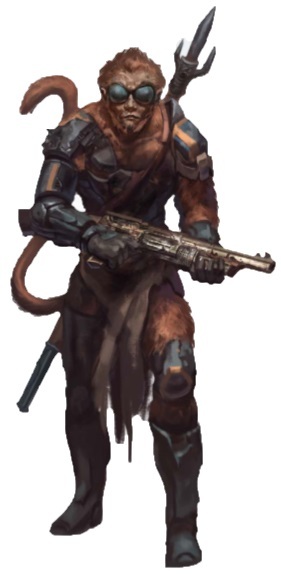
Natives to the Brethedan moon Marata, the maraquoi resemble humanoid monkeys. Their unique reproductive system has seven genders, all of which are necessary to reproduce, and as a result many are highly averse to killing, so as not to prevent reproduction altogether.
- Ancestor Veneration: Traditional maraquoi religion focuses on ancestor reverence over worshipping a specific divine entity.
- Bizarre Alien Sexes: They have seven sexes, all of which are necessary to reproduce. For the curious, they are:
- Three "fathers", the ilsha (earth-sire), qsha (sky-sire), and susha (water-sire), who contribute genetic material.
- The uisha (sharer), a "conceptual mother" who takes in the sires' DNA, conceives the fetus, and passes it on to...
- The klsha (bearer), similar to the Shirren Host gender, who carries the child to term, then passes the newborn child to...
- The mesha (cradle), who nurses the child in a marsupial-like pouch.
- And among all these is the zysha (facilitator), who for some reason has to effectively oversee all this and somehow still contributes to the child's DNA like the other six despite having no apparent physical contact in the process.
- Humanoid Aliens: They look like monkeys with insectoid compound eyes.
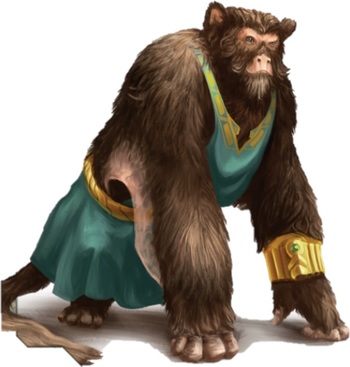
Natives of the jungle world Gjor III, their lack of technological development made it easy for the Azlanti Star Empire to conquer them. Technology continues to baffle them, but they are skilled ecologists even without such aids.
- Not Quite Flight: Neskintis are able to glide with the aid of skin membranes stretching between their arms and legs, but cannot gain altitude without external effects.

Orcs are rare, although records suggest they were numerous on lost Golarion. Today, they can be found in greatest numbers on Apostae, where most are drow-held slaves. Over the ages, however, some orcs have gained freedom, creating formidable armed clans on Apostae and a few other worlds in the galaxy, though many free orcs of Apostae remain second-class citizens who still serve the drow as mercenaries, technicians, and laborers.
- Behavioral Conditioning: Within orc enclaves on Apostae, a specialised program of reward and punishment accompanies education and tempers orcs for the jobs they are expected to perform. For example, an orc anticipated to be a technician might be conditioned to respond well and even take pleasure in technical work. An orc is ideally suited to their prescribed duties thanks to the extensive conditioning, which also keeps them bound to their drow masters better than any chains could.
- Slave Race: Orcs are enslaved by the drow on a grand scale.
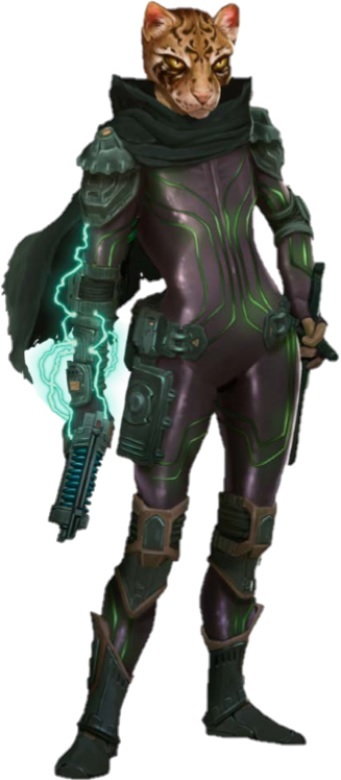
A species of feline humanoids from Vesk-6, conquered by the Veskarium after a long guerrilla war and "rewarded" for their tenacity with limited self-rule.
- Cat Folk: Look like leopards or jaguars, their spot patterns were traditionally used to decide their profession.
- Lightworlder: Their homeworld has slightly lower gravity and they get a penalty to strength.

Phentomites are native inhabitants of Orry, an unusual cluster of landmasses floating in regular orbits around a gravitational anomaly in Near Space. Thousands of years ago, the planet Orry was a technomagical utopia, but a massive industrial accident caused much of the world’s mass to explode into space. However, mystical gravitational forces created in this disaster allowed the land that survived to remain inhabitable, albeit with a thin atmosphere. Orry now consists of 10 country-sized landmasses, along with several dozen smaller formations, that slowly rotate around a central point—sometimes coming within mere feet of one another but never colliding.
- Future Primitive: Phentomite society has lost much of the scientific and magical advancement of its forebears. Today, phentomites engage in relatively low-tech artisanship, farming and trading.

Shapeshifting reptilians, reptoids infiltrate societies to further their unknown goals.
- Lizard Folk: In their true form, they're reptilian, crested humanoid aliens.
- Reptilian Conspiracy: They're reptilian shapeshifters who infiltrate and manipulate other species' societies for their own ends.
- Voluntary Shapeshifting: They can switch between their own form and that of a particular humanoid. They can change who their false form is, though this often requires staging the death of the old identity.

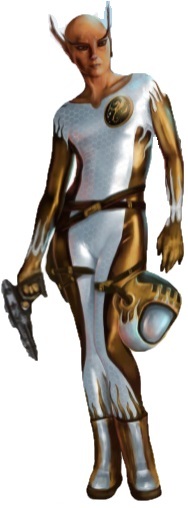
Natives to Triaxus, ryphorians appear in three subtypes depending of which centuries-long season their world is currently in. Though ryphorians are born to the winter type, modern technology allows them to change into whichever subtype they wish.
- Bizarre Alien Biology: Ryphorians have three appearances depending to their planet's season at birth, even when off-world. In winter, they grow short fur over their bodies, while in summer they are hairless and have larger eyes. The third form is for those born just before or during the transition between seasons.
- Dragon Rider: In the old days, the ryphorians of the Skyfire Mandate and other Allied Territories could form links with dragonkin, large Draconic Humanoids who allowed their smaller allies to ride them. Few ryphorians ride dragonkin nowadays, but they still enjoy the bonds, and many partner up as co-pilots.
- Rubber-Forehead Aliens: They look like elves with some feline features.
- Sudden Name Change: In pre-Gap Golarion, the name ryphorian was unknown and everyone called them Triaxians.

Samsarans are mysterious humanoids who experience an endless cycle of birth to death to rebirth. When a samsaran dies, they reincarnate into a young samsaran to live a new life. The memories of their past lives are hazy and indistinct, but most samsarans seek lives of balance and enlightenment to ensure their continuing rebirth.
- Alien Blood: It looks like water.
- Reincarnation: Samsarans reincarnate in an eternal cycle in search of enlightenment. Each time they are reincarnated, they retain some faint memories of their past life, but might have a vastly different personality.
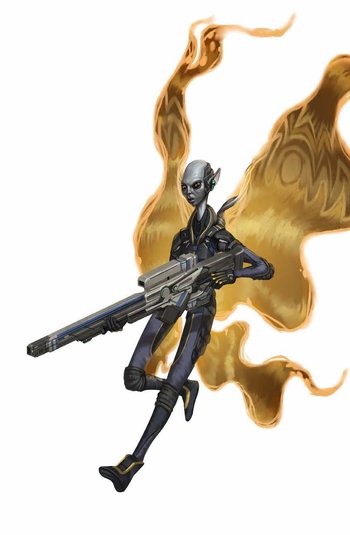
A tall species native to one of the planets that now makes up the Diaspora. They are capable of surviving in space for up to an hour, suppressing their breathing and growing solar wings to glide through the void.
- Cold Sniper: They make excellent snipers, especially since they can take up position outside of a space station or starship to fire on targets inside.
- Growing Wings: They can manifest wings of pure energy, but only in a vacuum.
- Noodle People: They're incredibly tall, with long spindly limbs.
- Progressively Prettier: In Pathfinder, the sarcesians' heads look like those of the Muun from Star Wars: tall and thin with a tiny face. Now they look more like large-eyed hairless elves.

One of the first species ground under the heel of the Azlanti Star Empire. Their homeworld of Eostrillion was taken from them and the species was beaten down into a race of sycophants.
- Number Two: They're the Star Empire's favored non-human species and hold the highest possible status for such a race, but they're still second class citizens.
- Sycophantic Servant: The responded to centuries of Azlanti oppression by becoming very good at being subservient.
- White-Collar Crime: Screedreeps who go bad tend to gravitate to this. With their size and dispositions, they're not much for violence, but their managerial talents come in handy as mob consiglieres.

Shakaltas are a species of highly intuitive psychic entities that inhabit Accara IV, a planet in the Vast with a very short day-night cycle. An adult shakalta’s body contains two souls, but has only one soul controlling outward activities at a given time. The inactive soul recedes and rests, conscious only of its mate. Cosmetic changes in the body reflect the active soul’s sense of itself. These visual variations allow nonpsychic creatures to tell each soul from the other.
- Energy Beings: Shakaltas are beings of coherent energy, do not need to breathe, and are immune to disease and poison.
- Fusion Dance: To enter adulthood, two shakalta souls must bond together. Psychic compatibility and spiritual connection are all that matter to potential soul partners, and both souls must consent. After two shakaltas agree to bond, they live the rest of their lives in the same body.

A race possessed of great height and grace, but their flesh is semitransparent and their bones limned with light. This combination makes shatoris’ eyes glow and their bones visible through their translucent flesh. Shatoris are living creatures, but centuries of exposure to the energies of the Boneyard have have extended each shatori’s natural life indefinitely and rendered them sterile.
- The Ageless: Shatoris neither age nor die of natural causes but, as a tradeoff, can no longer reproduce.
- Dying Race: Shatoris can no longer reproduce, and see each death among them as a potentially catastrophic loss.
- Voluntary Vassal: When the Azlanti Star Empire arrived in the Disaj system, the shatoris offered their services as analysts, scholars and magic-users, and were integrated into the Empire without bloodshed.

Shimreens are composed of glimmering crystal, and the average shimreen is 7 feet tall and weighs 600 pounds. Though their tall, angular bodies can be any color (or even clear), most tend toward cool, bright jewel tones such as blue, purple, or teal. Much like their radiant metropolises, shimreens glow from within.
- Crystalline Creature: Shimreens are composed of luminous crystal rather than flesh and blood.
- Shapeshifter Weapon: A shimreen can transform one of their arms into a crystal lance.
- Weird Beard: Some shimreens let the crystals around their faces grow wild to form clusters they call manes.

A race of peaceful, communal creatures from Vesk-3, skittermanders are good-natured if hyperactive mammals with six arms and furry bodies. They are instinctually helpful, which vexed the Veskarium when they attempted to invade, as the vesk code of honor forbid them from firing on a foe that wasn't interested in a fight.
- Badass Pacifist: If they are Obfuscating Stupidity, then they're masters of nonviolent resistance, having successfully resisted vesk control through sheer force of friendliness.
- Belly Mouth: As we see from the illustration, skittermander whelps have a lamprey-like bitey umbilical cord.
- Bizarre Alien Psychology: If they aren't a case of Obfuscating Stupidity, then they just genuinely don't understand that they've been conquered, or indeed the concept of being conquered, or simply see no reason to care. Either way, the Vesk are tearing their non-existent hair out.
- Contrasting Sequel Main Character: To the Pathfinder goblins in the free RPG modules. While goblins are Ugly Cute fire happy violent creatures that are mostly impossible to live with in civilized society, skittermanders are largely Ridiculously Cute Critters that are almost impossibly friendly.
- Heavy Worlder: Downplayed, but their homeworld has half-again standard gravity. This likely explains why they take no penalty to Strength despite being the approximate size of a human toddler.
- Keet: Their hyperactivity gives them an extra move action once per day.
- Killer Rabbit: Skittermander whelps are as cute as the adults, save for a secondary mouth they use to take bites out of large prey. It's normally all-but harmless given their diminutive size, but a swarm of whelps can skeletonize their homeworld's equivalent of a cow.
- Nice Guy: To an almost infuriating degree. Those that leave Vesk-3 tend to become bureaucrats for the sole purpose of helping as many people as they can.
- Obfuscating Stupidity: Some vesk suspect that they're intentionally obtuse in order to annoy their vesk "overlords" and maintain their autonomy while reaping the rewards of being part of the Veskarium.
- Ridiculously Cute Critter: They're adorable little fur balls. They're both less and more cute as whelps, as though their faces are even cuter, they have a creepy worm-like mouth on their stomachs.

Another race formerly originating from Golarion, the strix of the Pact Worlds live in a spire on the Fullbright side of Verces.
- Bird People: They have several subtle avian qualities. For instance their eyes are fixed in their skulls and they have to turn their whole heads to look around.
- Slave Race: They were originally bred as one by the syrinx, but since they seem to have vanished with Golarion, the strix in Starfinder are entirely free.
- Winged Humanoid: Despite their avian natures they do look more like this, as they lack feathers anywhere but their wings, don't have beaks, and have humanoid hand structures (though they do have digitigrade legs, and non-functional claws instead of nails).

Trinirs are natives of the usually frozen Ashypso. These small, android-like beaked humanoids lack a history, as they awakened in hibernation chambers only recently as their planet thawed. Thanks to the Gap (and possibly other unknown factors), trinirs have found little to indicate who they are or how they came to be. Some believe ruins of their ancient civilization might be found somewhere within the ice.
- Artificial Human: Like androids, trinirs are biomechanical constructs that have souls and are classified as humanoids instead of constructs.
One of three sapient species native to the Gjor III in the Azlanti vassal system of Gjor, tromlins are a bellicose people divided into two distinct subspecies who warred for ages on the plains and forest floors of Gjor III. The bloodseeker strain is a bipedal, reptilian humanoid, while tromlin hardshells are natural quadrupeds. Bloodseekers kill and eat any being too weak to oppose them, while herbivorous hardshells fight against their flesh-eating kin.
- Arch-Enemy: The two tromlin subspecies once warred for ages on their home planet, due to their belief in tribes of warring spirits. Now, even when serving in the same army, tromlins require strict leadership to prevent their rivalries from breaking out into violence.

Tryziarkas originated on the world Suron in the Vast. As their system’s star died, the tryziarka nations built dozens of legacy starships, each of which served as a self-contained biosphere capable of supporting life for the indefinite future. In these legacy ships, tryziarkas scattered across the stars in the hopes of finding new homes.
- Power Tattoo: The karakande symbiote forms a faintly glowing, tattoo-like pattern on the surface of a tryziarka's body. Tryziarkas can choose to imbue trusted others with their design, temporarily granting them a piece the karakande's magic.
- The Symbiote: In early childhood, each tryziarka enters a symbiotic relationship with a magical ooze known as a karakande. They see their ooze companions as an intrinsic part of themselves, and the magic they grant as part of their identities.
Varratanas are the primary sapient inhabitants of the Vast world of Varratien, known for the winds that sweep from its high, rocky bluffs across its wide, stormy seas. They look like humanoid dinosaurs.
- Hive Caste System: Varratanas are trimorphic depending on the circumstances of their birth: blusterwind varratanas have broader shoulders and a triceratops-like crest; carrywind varratanas have long, silky feathers in place of hair; and fracturewind varratanas have shorter limbs and flattened skulls with ridges like those of a pachycephalosaur.

Natives to Verces, the verthani are a highly cooperative race that specializes in biological and cybernetic augmentation.
- Ace Pilot: Aside from cybernetics enhancement, this is their race's hat. They were the first race to develop space travel, and the first to launch a ship through the drift.
- Cyborg: Nearly all of them, and even the ones who aren't are more capable of receiving them than other races.
- Fantastic Caste System: Verthani are divided into three castes known as the Augmented, who use technology to modify their bodies and travel in outer space in aetherships; the Pure Ones who reject bodily augmentation and concerns themselves with government, farming, and commerce; and the God-Vessels, clerics who permanently burn holy symbols on their skin. In order to prevent any caste from gaining too much power, the Augmented and God-Vessels are only allowed to marry Pure Ones.
- Noodle People: Their gangly limbs are one of the things that sets them apart from humans.
- Perfect Pacifist People: Subverted. Their nations haven't been to war for longer than anyone can remember, but their relationships with the Outlaw Kingdoms are far less peaceful, and can even be a bit bigoted.
- Rubber-Forehead Aliens: They look like humans with large mouse-like eyes and longer limbs.
- Sudden Name Change: The verthani were originally just called Vercites after their home planet in Pathfinder, as no one on Golarion knew their racial name back then.

Wolf-like humanoids from a frigid dying world seeking to save their people.
- The Apocalypse Brings Out the Best in People: Their homeworld's star is dying, and they've responded by building strong communities that look out for one another and venturing among the stars to find a long-term solution.
- Disability Superpower: Two-thirds of all vlaka are born blind or deaf, but with stronger other senses that negate the usual penalties and give them blindsight.
- Team Spirit: Vlaka get bonuses to "aid another" actions and can transfer their resolve points to allies.
- Wolf Man: Physically, vlakas resemble bipedal wolves.
Larger, smarter relatives of Castrovel's squoxes, blessed by the goddess Daikitsu with a fragment of True Speech.
- Animorphism: Vulkarisu are not shapeshifters by default, but like kitsune can take the "Vulpine Form" feat that lets them shift into an ordinary squox.
- Cunning Like a Fox: Vulkarisu characters have a choice between a bonus to Acrobatics and Diplomacy checks or the dirty tricks Improved Combat Maneuver feat.
- Fox Folk: Vulkarisu are humanoids with squirrel and fox features. According to their folklore, they're descended from one of the Nine Bright Grains that serve Daikitsu, the Lady of Foxes.
- Mix-and-Match Critters: The vulkarisu resembles a ysoki-sized cross between squirrel and fox.
- Multiple-Tailed Beast: Have access to the "Vulpine Magic" feat, though any additional tails a vulkarisu grows through feats aren't prehensile like their first one.
- Omniglot: Vulkarisu can't speak fluently in every language, but their Mystic Voice ability allows them to attempt Diplomacy checks with creatures they don't share a language with, including animals.
- Prehensile Tail: A vulkarisu's first tail can manipulate objects like a hand does.

A species from a watery world, the woiokos are separated into two subspecies. The Deepborn live deep in the oceans, while the Floatborn live in floating cities on the ocean's surface.
- Fish People: Eel people.
- Humanoid Aliens: They look like humanoid eels.
- Super Not-Drowning Skills: Both subspecies can breathe in water as well as in air.

Hailing from the Near Space planet of Worlan, worlanisi are small blue humanoids known for their uncanny luck. From an early age, worlanisi are taught to see the lucky side of virtually every event. Even situations that others might see as significant downturns in fortune, worlanisi typically interpret as blessings in disguise.
- Born Lucky: Worlanisi are known across the galaxy for their preternatural luck. This luck seems to stem from some inborn trait, and worlanisi society has affirmed and integrated this luck into its collective mindset for generations.
- Promoted to Playable: Xulgaths in Pathfinder were only monsters, but were made a new ancestry in 2023.
- The Social Darwinist: Due to frequent resource scarcity throughout their history, xulgath society is quick to disregard those deemed weak, which can come across as callous to other species.
- Starfish Language: Xulgaths speak a language that incorporates complex pheromones and spoken words, so non-xulgaths can find them reticent and off-putting and are often unable to discern the full meaning of what a xulgath says.
- Weaponized Stench: Xulgaths have acute control over their odour and can emit a nauseating stench as a special attack.
Monstrous Humanoids

- Insectoid Aliens: Astriapis are bipedal arthropods with chitinous exoskeletons, insectile wings and large powerful mandibles.
- Lost Technology: The decades of technological development and striving that created Colveare's technological marvels largely occurred during the Gap. Without their people's lost knowledge, astriapis are now locked in a race against time to rediscover and reverse-engineer their planet's intricate workings before those ultra-complex systems begin to catastrophically degrade and fail.
- The Theocracy: Astriapi society is a unified theocracy, ruled by priests dedicated to the preservation of the planet through learning and faith.

The contemplatives of Ashok were once a humanoid race native to Akiton. Upon achieving psychic powers, they allowed their bodies to wither as they fed their minds and are now little more than floating brains carrying vestigial bodies.
- Crippling Overspecialization: Contemplatives are very hard to play as anything except a spellcaster, thanks to their incredibly focused ability score adjustments and the "Atrophied" trait preventing them from using two-handed weapons without completely immobilizing themselves.
- Meaningful Rename: Contemplatives eagerly discard their childhood names upon reaching adulthood in favor of an appellation they choose for themselves.
- My Brain Is Big: So big that they make up 70% of their body mass.
- Proud Scholar Race: They're a society of scientist-monks.
- Royal "We": Contemplatives' speech reflects generations of external isolation and internal communion, as even individuals refer to themselves with the first-person plural personal pronoun rather than with the singular.
- Squishy Wizard: They're brilliant and make excellent spell casters, but their bodies are incredibly frail.

Found primarily on Castrovel within the Pact Worlds, the formians are a communal insectoid race divided into castes for different roles.
- Arch-Enemy: They've been at war with the lashuntas for thousands of years, with peace only taking effect in the last few decades.
- Bee People: They have a structures social system dominated by queens.
- Elaborate Underground Base: Formian hives tend to run for miles underground, leaving vast swathes of surface wilderness untouched.
- Insectoid Aliens: They're quadrupedal ant people that live in hives.
- My Species Doth Protest Too Much: Some formians don't agree with the strict social systems of the formian hives. There are several organizations dedicated to helping habilitate these formians for independent life.
- Promoted to Playable: Formian warriors are another monster race of monsters from the original Pathfinder that became playable in the Alien Archive of Starfinder. The other formian castes remain unplayable.
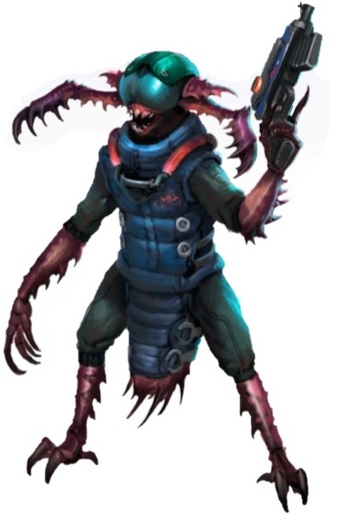
An arthropodan species native to Bretheda. They weave balloons from webs which they use to float through the air and can spit fire to defend themselves. Their society forbids all but the most basic of tools and those who leave home to venture the stars are considered dead by their kin.
- Ace Pilot: Those who do leave Bretheda find themselves adept pilots.
- Big Creepy-Crawlies: They're insects bigger than most humanoids.
- I Have No Son!: The haan who venture off world are considered dead to their families.
- Mix-and-Match Critters: They combine aspects of bombardier beetles, spiders, and eurypterids (sea scorpions).
- Technophobia: Almost all haan consider technology taboo.
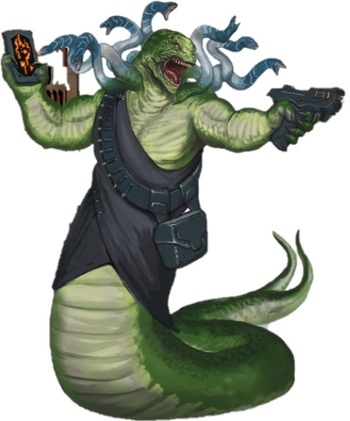
- Bizarre Alien Biology: They've got multiple heads and multiple sets of redundant organs.
- Genius Bruiser: Large sized, and with racial bonuses to both strength and intelligence.
- Made of Iron: Large and hearty, they've also got multiple sets of redundant organs.
- Man Bites Man: Ther multiple sets of powerful jaws and sharp teeth allow them to bite enemies and hold on and grapple enemies once bitten.
- Multiple Head Case: They have one primary head, but have several (artwork depicts both six and seven) other, smaller heads that look like snakes sprouting from their neck ad shoulders. Their language is particularly hard to master because all of these heads speak together in a way that isn't easy to immitate, to the point that many other races choose to send whole teams of diplomats trained to speak together as a chorus to deal with the ilthisarians.
- Snake People: They're serpent-like aliens with a humanoid torso, but with a snake's tail as a lower body that forks into two tips at the end.

- Beware My Stinger Tail: Ixtangis have long, flexible tails that end in a scorpion-like stinger.
- Chameleon Camouflage: Ixtangis are chameleon-like humanoids that can manipulate the liquid crystals beneath their layer of transparent scales. They are able to change the structure and colour of these crystals at will and can even become functionally invisible by mimicking the scenery behind them.
- Floating Continent: The majority of ixtangis live in floating islands, called country ships, which levitate hundreds of feet above Doganga's verdant jungle canopies, and are anywhere from ten to hundreds of miles across.
- Lizard Folk: Ixtangis are a species of chameleon-like people.

- Hidden Elf Village: The Starfinder Society module that introduces them gives them this characterization, as they're far more technologically-advanced than they appear, as they're trying to keep a low profile from the Jinsul Empire.
- Video Game Caring Potential: This race was made available for all Society members to play without requiring a boon (provided they bought Alien Archive 3) due to the majority of Society players opting to keep the izalguuns' advanced tech secret during their introductory adventure.

- Frog Men: Jububnans resemble human-sized toads that stand on a single stout leg.
- Truly Single Parent: A jububnan can perform parthenogenesis to spawn dozens of eggs several times during their lifespan.
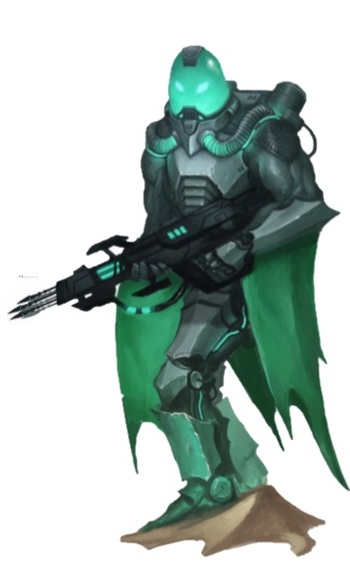
Natives to the Brethedan moon of Kalo-Mahoi, the kalo are an aquatic species that cannot survive out of the water without specialized gear. Resembling a cross between a fish and a bat, they place an emphasis on tradition, using ancient titles and names for modern positions.
- Action Fashionista: They're famous for both their fierce and valorous hunters, and their cutting edge fashion.
- Glowing Eyes: Each kalo eye possesses a faint and independently controlled form of bioluminescence that kalos use to visually signal each other.
- Humanoid Aliens: They're capable of bipedal movement, but they're primarily adapted to life underwater.
- My Nayme Is: It's common for kalo parents to alter existing names in some way, such as changing the spelling but keeping the sound the same, as an exercise in creativity and to ensure their child has a name that will stand out.
- Super Not-Drowning Skills: They're an aquatic race and as such are perfectly capable of breathing water. Unfortunately, breathing air is an impossibility.
- Weird Beard: The lower half of a kalo's face is covered by sensory tendrils, which might resemble beards.

- Heavy Worlder: The megalonyxa is a stocky species that hailed from the heavy-gravity world Karnoq.

A sentient species resembling walruses with opposable claws on their side flippers, morlamaws are pre-spaceflight natives of the cold, watery planet Arniselle. While the majority of the race remains on their home world, a few adventurous souls have joined the crews of starships to see the universe.
- Intelligent Gerbil: An alien race that is, for all intents and purposes, a species of blue talking walruses.
- Warm-Hearted Walrus: They tend to be good-natured.
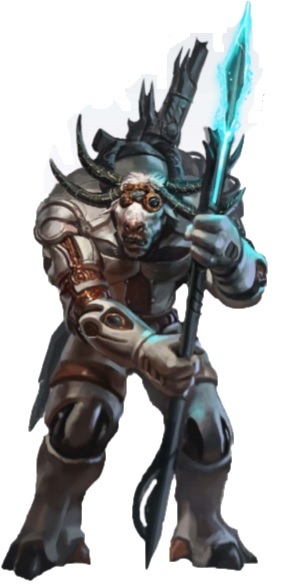
A rare race, nuars resemble minotaurs and claim to originate from Golarion. Their culture draws from bits and pieces of many others, particularly orcs.
- Dash Attack: They have the ability to charge and attack opponents in the same turn without incurring the usual penalties.
- Dead Guy Junior: Their species is likely named after Nuar Spiritskin, the Minotaur Prince of Absalom in Pathfinder.
- Do Not Call Me "Paul": Young nuars often select a name for themselves upon leaving the safety and control of their parents' home, and nuar settlements consider using the old name an insult since that rejects the nuar's right to self-identify.
- Horn Attack: Their horns can used as Natural Weapons much like vesk claws are.
- Our Minotaurs Are Different: Nuars are minotaur-like creatures with formidable frames and roughly bovine faces, hooves and horns and claim to be distinct from their bigger, less smart minotaur relatives. They have natural grasp of complex patterns and shifting connections.
- Smarter Than You Look: Most people assume nuar are stupid because of their bestial appearance. Most people are very wrong; on average, nuar are smarter than humans.
- Transforming Weapon: Their signature technology, the maze-core, allows one to build these.

- Salt Solution: Osharus (except those adapted to living in the sea) are harmed by salt and salt water.

- Multi-Armed and Dangerous: Four spindly arms extend from a psacynoid's torso, two on each side.

- Multi-Armed and Dangerous: Quorlus have three arms each.
- No Biological Sex: Quorlus have no clear biological sex. They reproduce by sharing plasma, each would-be parent extruding nodules that develop into young quorlus.
- Silicon-Based Life: Quorlus are explicitly described as silicon-based creatures.

- One-Gender Race: All ramiyels are female.
- Snake People: A ramiyel has an upper body like that of a female human, and a scaled serpent body below the waist.

- Our Centaurs Are Different: Sazarons are centaur-like creatures with a lower body similar to an iguanodon, and the torso of a large humanoid.
- Tail Slap: Sazarons have long tails tipped with a large knob of bone that they can wield offensively.

- Archaic Weapon for an Advanced Age: Due to the scarcity of resources they have access to, they've become very proficient with archaic weapons and receive bonuses to them.
- Bizarre Alien Locomotion: They have four legs, but rather than being arranged in a centaur-type configuration, it's more like if you had two legs coming out of either socket in your hip.
- The Exile: A whole race exiled from their homeworld by a virus that will kill them if they go back. Unfortunately for them this happened before the advent of drift travel, when they were confined to a single system. And perhaps more unfortunately, their homeworld is the only planet in their system that sustains life.
- Future Imperfect: Knowledge of exactly what it was that caused them to flee their planet has been lost to them and most believe that it was some crime against the gods for which they are being punished for all eternity.
- Sins of Our Fathers: Self-imposed by the Exilytes, a cult like organization that permeates every level of Seprevoi society. They believe that their race must pay eternal penance for some forgotten crime, and no technology or magic can ever bring them back to their homeworld.
- Space Station: They are confined to a series of them in orbit around their home planet, which they can no longer go to.
- The Virus: They created a biological weapon that only targets their own race. Unfortunately it got loose and became air born, rendering their entire planet uninhabitable for their species, though other races are unaffected. The seprevoi themselves have forgotten this, and believe the virus to be a divine punishment.

Collectively called the shobhad-neh, these four-armed giants are native to Akiton. Living in low-tech nomadic societies, they place great value on martial prowess and personal honor.
- The Big Guy: They tower over most races.
- Captain Ersatz: They're pretty much the Starfinder equivalent of Green Martians.
- Multi-Armed and Dangerous: They have four arms, are larger than most races, and place great value on combat ability.
- Progressively Prettier: Inverted. While not depicted as particularly attractive in Pathfinder, they were still relatively
 ◊ human looking
◊ human looking ◊, aside from being green-skinned, four-armed giants. In Starfinder they're hideous
◊, aside from being green-skinned, four-armed giants. In Starfinder they're hideous ◊ monsters
◊ monsters ◊ with inhuman mouths, tusks, clawed hands and toes more extreme than any orc. This is likely to increase their resemblance to the Tharks on whom they are based.
◊ with inhuman mouths, tusks, clawed hands and toes more extreme than any orc. This is likely to increase their resemblance to the Tharks on whom they are based.

- The Worm That Walks: A spathinae colony is a swarm of hundreds of inch-long component insects that swarm together in a humanoid shape.
- Mage Species: The arcane component in the syngnathrix genetic code expresses itself in most individuals as an affinity for magic.
- Multiple-Tailed Beast: Most syngnathrixes have two or three tails.
- Nay-Theist: Modern syngnathrix culture rejects divine worship and believes that all beings, including gods, are manifestations of a greater cosmic whole, and that a god's power is granted by its worshippers.
- Prehensile Tail: Syngnathrix tails are prehensile and can walk on land with training.

- Laser-Guided Amnesia: Telias have exceptional control over their memories. Some can forget entire centuries, though most trim only bad habits, bits of bias and old grudges.
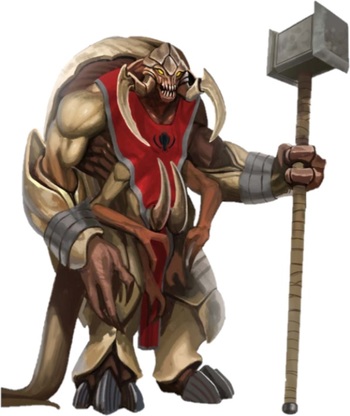
- Face of a Thug: Don't let their huge size and monstrous buggy faces fool you; trox are kindhearted souls.
- Fantastic Race Weapon Affinity: Their racial weapon is the hammer, which can be used both as weapons and as constructive tools.
- Gentle Giant: Trox are typically lawful or neutral good, and overall have kind hearts.
- Lightning Bruiser: They're a Large race with bonuses to Strength and Constitution, a base land speed of 40 feet, and they're the only race with eight base HP.
- Martial Pacifist: While trox are generally peaceful creatures, they are still some of the biggest and strongest people in the galaxy and will gladly bludgeon evildoers to death.
- Papa Wolf: In Pathfinder, trox could enter a pseudo-rage when they took damage. In Starfinder, trox go into a frenzy when their friends get hurt.
- Progressively Prettier: A variant; while they're still monstrous-looking beetles, their personalities are greatly improved from Pathfinder. In Pathfinder, trox were wild,
 Chaotic Neutral savages enslaved by the duergar to be used as war machines. The trox in Starfinder are closer to the original trox that the duergar corrupted; gentle, peaceful emissaries who worship the Forever Queen.
Chaotic Neutral savages enslaved by the duergar to be used as war machines. The trox in Starfinder are closer to the original trox that the duergar corrupted; gentle, peaceful emissaries who worship the Forever Queen.

Native to the superheated oceans of Oyojii, the vilderaros are recent additions to the Azlanti Star Empire. They might not remain so for long, as Azlanti monoculture is proving to be a difficult burden for them to accept.
- Bizarre Alien Reproduction: All vilderaros can reproduce asexually; they develop the ability to reproduce sexually (which is preferred, due to it creating more variety within their Genetic Memories) later in life.
- Genetic Memory: Vilderaro offspring inherit knowledge from their parents.
- One-Gender Race: The entire species defaults to the feminine grammatical gender.
- Starfish Aliens: They look somewhere between a sea cucumber, a sea anemone, and a literal starfish, prefer to lie flat on the ground but typically stand upright on their three legs while around other species, have tentacles for arms, are radially symmetrical, and can reproduce via parthenogenesis but prefer not to.
- Truly Single Parent: In times of need, vilderaros can reproduce via parthenogenesis, but this is considered less than ideal.
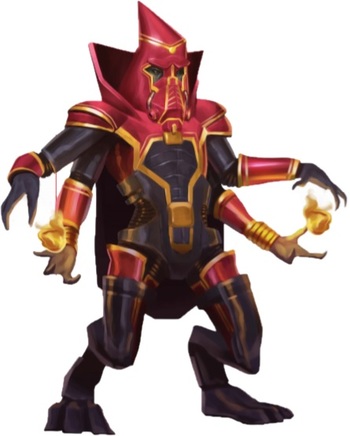
A mysterious race, the witchwyrds were the progenitors of the kasathas and shobhads.
- The Faceless: In all their images, they're wearing distinct read and yellow headdresses that hide everything but their eyes.
- Multi-Armed and Dangerous: They have four arms and are capable of firing magical force projectiles.

Natives of Akchios, these ocean dwellers use hormone supplements to keep their chitinous summer shells year-round and allow them to leave their watery home. They remain vulnerable to changes in temperature and often wear environmentally controlled suits to maintain a constant temperature.
- Expy: They're very reminicent of the prawns from District 9.
- Humanoid Aliens: They look like humanoid crustaceans.
- The Voiceless: Their bodies were meant to function in an aquatic environment, including their vocal systems. They need specialized masks to adapt their voices to tones and volumes audible in air.
Vermin

An underground species who specialize in digging, they've only just made contact in the past few decades, when outsiders stumbled upon them. Though intentionally wary of the outsiders, a mutually beneficial trade agreement was able to be reached. Even those that go out into the galaxy prefer to be alone, or with another burrowing species that can share their love of digging.
- Dash Attack: Bolidas are able to roll themselves up into a ball and charge at enemies, gaining multiple benefits from doing so.
- Day Hurts Dark-Adjusted Eyes: Being a species naturally adapted to being underground, bolidas have light blindness.
- Hermaphrodite: All bolidas can both carry and fertilize eggs.
Magical Beasts

- Reluctant Ruler: Most dromada herds elect their leaders democratically, but because an average dromada has no interest in taking on a leadership role, the herd itself nominates candidates for political office, whether an individual wants to run or not.

- Funny Animal: Hanakans resemble bipedal oviraptors that attained sapience.
- Mage Species: Hanakans generate magic of their own. Hatchlings often flare with harmless sparks or uncontrollably change colour. Even without further training, a typical hanakan can smell magical auras and perform minor arcane feats.
- The Symbiote: The adaptive symbiotic bacteria in hanakan lungs allows them to breathe in a broad range of environments.

- Prehensile Tail: Huitz'plinas' tails are as effective as a hand at manipulating objects.
- Spike Shooter: A huitz'plina's body is covered in long, glimmering spines, which can be deadly when launched at enemies.
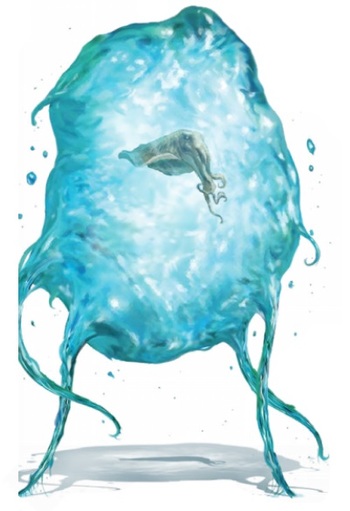
Diminutive psychic creatures from the deep oceans of Parin. The Azlanti Star Empire nearly wiped them out through pollution, not realizing they were sentient, and they have since integrated with the Empire in order to disperse across colonized space and ensure their race can't be wiped out in one fell swoop.
- Little Green Man in a Can: Being aquatic cephalopods the size of small cats, they couldn't normally adventure on land or use vehicles and equipment made for humanoids. Stellifera who leave the seas use their Mind over Matter abilities to construct mobile aquariums/environment suits out of water.
- Octopoid Aliens: They look more like cuttlefish than octopodes, but the same idea.
- Psychic Powers: They're telepathic and telekinetic.
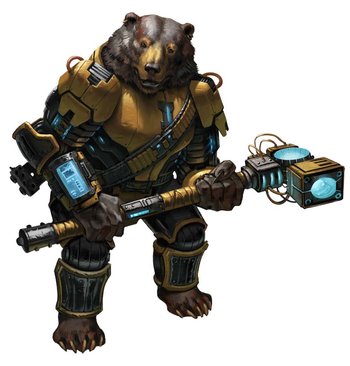
It's a bear. Originally a non-sentient creature given self-awareness and cognitive ability, uplifted bears enjoy natural science and often share communities with one another.
- Bears Are Bad News: Played With. Sometimes they pretend to be this to push for deals or For The Lul Z.
- The Unintelligible: Despite their intelligence, uplifted bears still have normal muzzles, and usually prefer to use telepathy.
- Uplifted Animal: Uplifted bears were modified to increase their cognitive ability to full self-awareness.

The primary race of the crystalline world of Dykon, Urogs are large, plodding snail-like creatures made of shimmering crystal. Though they are brilliant mathematicians, they have no real sense of tact, so they tend to rub other races the wrong way with their constant criticism and bluntness.
- Brutal Honesty: Urogs value frankness and getting to the heart of a matter far more than protecting the feelings of others.
- No-Sell: Since urogs can break off and absorb only the molecules they need and leave aside the others when eating, they are almost impossible to poison or drug.
- Silicon-Based Life: They developed on a world that was full of these.
- Starfish Aliens: They look like some combination of snail, turtle, and insect, to say nothing of the fact that they appear to be made of some crystalline substance.
Plants

A plant race originally created on Golarion long ago. Tired of being eaten by unscrupulous neighbors over the centuries, the Ghorans collectively abandoned the entire system soon after spaceflight was developed into order to find a homeworld of their own. Finding a planet they called Ghorus Prime, they eventually developed into two sub-races: the small saplings and the towering oaklings.
- Anthropomorphic Food: The intelligent humanoid descendants of magically bioengineered mobile vegetables.
- Plant Person: Ghorans are intelligent plants with humanoid forms.

- Mushroom Man: Hortuses are sapient fungi that possess human-like arms and legs.

- Cyborg: Some biomechanical augmentations have become so prevalent that raxilites consider them to be as much a part of their species as their organic bodies. Chief among these augmentations are the Internal Mobility Augmentation System and the Lifting Floret Activation Network, whose implantation is standard practice for raxilite sprouts.
- Floating Continent: Most raxilites live in flying cities that stay aloft through a combination of gas-filled chambers, clever aerodynamics and biotech thrusters.
- Hermaphrodite: A raxilite has both male and female reproductive organs, and to reproduce, two or more raxilites gather to exchange pollen.
Fey

- Fantastic Caste System: The majority of kiirintas divide themselves into two castes: the Reflectors and the Builders. The Builders focus on physical pursuits and serve as warriors and hunters, whereas the Reflectors focus on mental pursuits, studying magic and strategy. The castes are equal in terms of status.
- Emotion Bomb: Moyishuus can project their daily dominant emotion onto others with their soulfeel ability.
- Mood-Swinger: Moyishuus are changeable and temperamental, always embracing their most powerful emotions.
- Young and in Charge: Scuridays tend to favour young politicians (with elders serving as advisors), since they believe that youthful imagination drives innovation.

- Day Hurts Dark-Adjusted Eyes: A svartalfar exposed to bright light is blinded for a round, and dazzled as long as it remains in areas of bright light.
- Promoted to Playable: In Pathfinder, svartalfars were a monster race, before being made playable.
Dragons
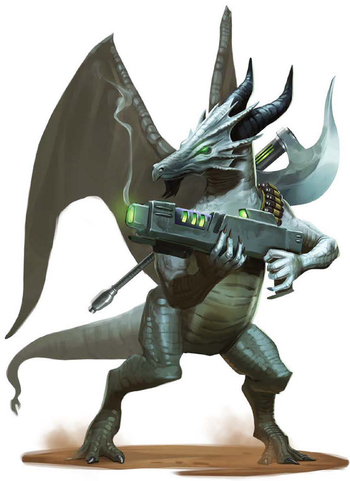
A race native to Triaxus, dragonkin resemble humanoid dragons. They are capable of forming a permanent bond with a partner, a deep and meaningful connection that ends only with death.
- Amazing Technicolor Population: Dragonkin have all the same varieties as both chromatic and metallic dragons.
- Draconic Humanoid: Dragonkin can stand on their hind legs much more easily than true dragons, and have opposable thumbs that allow them to wield weapons as humanoids do.
- Promoted to Playable: In Pathfinder, they were considered effectively a type of monster, albeit one close to humanoids. Starfinder allows you to play as one, size and all.
- Psychic Link: Back in the day, dragonkin linked with ryphorians, whom they then allowed to ride them. In modern times, there is far less need to riding a dragon into battle, but the link still makes them excellent copilots.
Aberrations

- Ape Shall Never Kill Ape: Since astrazoans aren't especially numerous, they exercise considerable caution in protecting one another to preserve their species. Except in extreme circumstances, astrazoans avoid killing each other, even when on opposing sides of a conflict.
- Eyes Do Not Belong There: Each of an astrazoan's arms has a large eye embedded about halfway down its length along the backside.
- A Form You Are Comfortable With: Astrazoans maintain their shapeshifted forms not to deceive or even out of fear, but out of consideration for their neighbors, as they understand that their natural form can be disturbing to humanoids.
- Hermaphrodite: Astrazoans can form both male and female reproductive organs and are effectively hermaphroditic.
- I Have Many Names: Most astrazoans choose a different name for each of their various identities.
- Not So Extinct: Astrazoan DNA samples are suspiciously similar to that of the ilee, the original natives of Apostae that supposedly went extinct.
- Rubber Man: An astrazoan's jellylike flesh is comprised of long muscle fibers that can dislocate, flow and realign into new configurations as needed, allowing them to squeeze through narrow openings and close wounds with ease.
- Starfish Aliens: In their natural form, astrazoans look like seven-limbed, human-sized starfish with cartilaginous skeletons and jelly-like flesh.
- Voluntary Shapeshifting: Astrazoans can assume the appearance of almost any creature of the same size. However, unfamiliar limbs usually aren't fully functional. An astrazoan taking a kasatha shape has limited control of their extra arms, just as taking a strix shape results in flappable wings that aren't strong enough for actual flight.
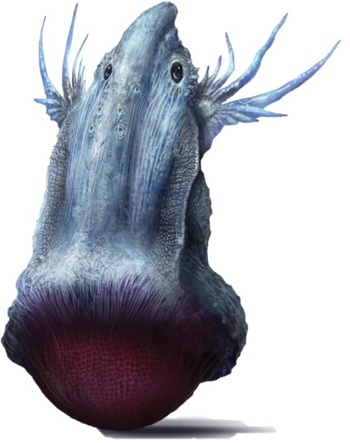
- Bizarre Alien Locomotion: They roll on a single sphere-shaped foot.
- Keet: They're very hyperactive; they literally cannot sit still for any length of time or else they start to experience a sensation similar to claustrophobia that causes them to hyperventilate and pass out.
- Starfish Aliens: A bantrid is a single column head/torso mounted on a spherical, rolling foot, with two sets of hand-like tentacles extending from either side of their bodies. They also have no sense of smell at all.
- Thrill Seeker: They're always in search of new experiences.
- Truly Single Parent: They reproduce via budding.

The barathus are natives to the gas giant Bretheda. Resembling floating, tentacled brains, barathus are capable of modifying their own genetic code and combining together into larger, more powerful collective entities. Early stage barathus are about the size of a human and enjoy wandering, exploring other cultures and societies.
- Adaptive Ability: They can adapt their bodies at will, gaining more powerful options as they mature.
- Fusion Dance: They can combine into larger beings that have their own intelligence. Barathu "corporations" can be made of hundreds of smaller barathus. Larger barathus can split off some of their components, usually to serve as representatives for the larger entity.
- Living Gasbag: They vaguely resemble something like a giant jellyfish or sea squirt, with no discernible external features save for long, trailing tentacles and filled for the most part with lighter-than gases that allow them to float through the endless skies of their gas giant homeworld.
- Promoted to Playable: Brethedans in Pathfinder were considered just another race of monsters. In Starfinder, they received rules as player characters in the first Alien Archive.
- Starfish Aliens: They look like floating, translucent masses of gelatin, with clusters of tentacles trailing from their undersides. They are adapted for living in the endless skies of gas giants, and can modify their own genetic code to suit their needs and join together in large numbers to form enormous, hyper-intelligent shared consciousness.
- Sudden Name Change: The barathus were originally just called Brethedans after their home planet in Pathfinder, as no one on Golarion knew their racial name back then.
- Underground Monkey: In The Ruined Clouds, the fourth part of the Dead Suns AP, the daelns (a barathu-like race native to Nejeor VI) are treated as variant barathus by the game itself despite being unrelated species that live on completely different planets.

- Hermaphrodite: Cephalumes, like most plants, are monoecious—each individual has both male and female organs and any cephalume can fertilise any other cephalume.
- Human Resources: Cephalume buildings and starships are made from the calcified remains of their dead. Many cephalumes continue to regard these objects as the people they once were, and even hold conversations with them to talk out their problems in times of stress.
- Overly Long Name: Because cephalumes can flash an extraordinary amount of information to each other in a very short time, a name can be exceptionally long.
- Plant Person: Despite being classified as aberrations, cephalumes have an internal physiology more like that of plants.
- The Speechless: Cephalumes have no sound-producing organ.
- Starfish Language: Cephalumes speak Lumos, language based on their bioluminescence. This language begins with a single dot of light somewhere on a cephalume's skin. Each cephalume boasts hundreds of lights on their body, has remarkable control of each light's intensity and colour, and can flash each light on or off many times in a single second.
- The Symbiote: Cephalumes form symbiotic unions with small bioelectric arthropods known as krikiks. No krikik has ever successfully bonded with a non-cephalume, and, indeed, most seem unwilling to even try.

- Slave Race: Few embri realise their rigid social hierarchy is controlled by the forces of Hell. Scheming devils direct all embri activities from the secret tunnels beneath the surface of Embroi.

- Death by Childbirth: An adult ijtikri can begin a final metamorphosis at any point. After several weeks, the ijtikri fertilises stored eggs and disperses them, then dies.
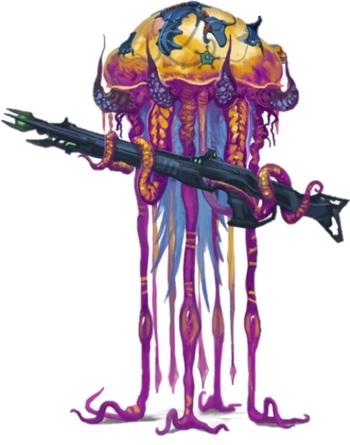
- The Federation: The most advanced and powerful economic and military force on Primoria is the Council States, a commercial and defensive confederation of scyphozoan city-states and tribes.
- Funny Animal: Scyphozoans are a race of civilised jellyfish that can breathe air as well as water, has two prehensile tentacles ('arms') and multiple ambulatory tentacles to walk on land.
- Organic Technology: Scyphozoan technology depends on genetically manipulated organisms that function similar to mechanical and electronic devices.
- Poisonous Person: Scyphozoans can secrete corrosive acid with their tentacles.
- X-Ray Vision: The scyphozoan's bell and tentacles are sensitive to vibrations in the air or water, allowing them to sense nearby creatures even if they can't see them.
Constructs

- Blank Slate: When an amrantah dies, the soul travels to a ghost forge to be reborn. While this offers immortality of a sort, souls reborn this way are inevitably reimprinted, emerging with a blank mind and personality.
- Ridiculously Human Robots: Amrantahs are living machines made from highly advanced magitech and imbued with the soul of a long-dead person from Amran. They benefit from natural and magical healing, can be raised from the dead, are immune to disease but not poison or drugs (which can disrupt their internal fluid). Amrantahs replenish internal energy and fluid by eating and drinking, and they must rest and can dream, but don't breathe or suffer the environmental effects of being in a vacuum.
- Hard Light: Holograms are true AIs that interact with the physical world by projecting a hardlight body around their core.
- Synchronization: Damage dealt to a hologram's hardlight body also affects its core.
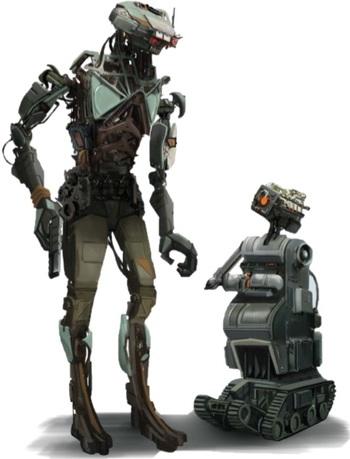
- Ridiculously Human Robots: SROs are constructs with positronic brains so complex that they've attracted souls and developed free will. They can eat and drink but don't need to, and they have to sleep by entering offline mode for 8 hours every day. Because of their healing circuits, SROs can heal naturally and be resurrected like organic creatures, and healing spells can also affect them to a lesser degree.
Oozes

- Blob Monster: Entu colonies without hosts are amorphous pools of opalescent slime with malleable pseudopod-like organs.
- Emotion Eater: Entu colonies feed on emotion and thought.
- The Symbiote: Some entus consensually merge with other sentient creatures. Their adaptable cells mimic the host's brain and nerve tissue. Their mycelia intertwine with their host's central nervous system, creating new synapses and enhancing sections of the host's brain. Despite inhabiting the host's body, the entu fungus retains a separate consciousness which intertwines with its host through shared functional memories and sensory input.
- Uplifted Animal: Entu symbiotes' offspring are often born with entu cells integrated into their bodies and brains, leading to the uplifting of entire species of animals.

- Blob Monster: The first playable race of oozes in Starfinder, selamids have mutable, flexible bodies made of protoplasm.
- Extreme Omnivore: Selamids can eat nearly any organic matter.
- Mobile City: Selamids build their cities called megadoplexes upon the backs of their gentle, half-mile-long cousins called megadolorids.
- No Biological Sex: Since they reproduce asexually via binary fission, selamids have no concept of biological sex, and game material refers to them by the pronoun 'it'.
- One Size Fits All: Invoked: equipment and armour of the appropriate size never needs to be adjusted to allow a selamid to use it.
- Truly Single Parent: Selamids reproduce by dividing into two identical ones at the end of their lifespan.
- I Have Many Names: Thyrs adopt a new name or alter their existing name at will.
- Living Gasbag: A thyr is a swirling cloud of buoyant gas whose outer molecules form a thin, malleable membrane. Since this physiology is impractically fragile and lightweight, they typically wear full-body attire to stabilise their form.
- Who Even Needs a Brain?: Thyrs have no brains and form memories and skills by recombining their gases into complex neurological chains that float microscopically throughout their bodies.
Undead
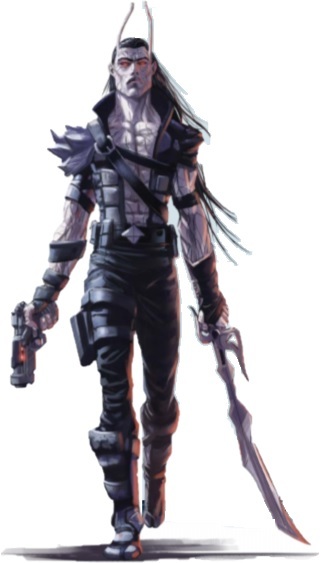
- Technically-Living Zombie: Despite being considered undead, borais are only mostly dead bodies that still have a sliver of the soul inside, usually because of a botched resurrection or because the borai was too stubborn to die. They still need to breathe, eat and sleep like normal living people.

- Heavy Sleeper: A varculak needs rest like a living humanoid, sleeps very heavily, and is particularly difficult to wake up.
- Roaring Rampage of Revenge: Some varculaks remember only the circumstances of their death, causing them to focus on vengeance. Even when this is done, a varculak can become obsessed with the chain of blame, condemning nearly anyone for even a tenuous connection to their death.
Outsiders

Usually being born as a result of a tryst between a good-aligned outsider and a mortal, assimars are the result of that. Already outliers in the community, their potent blood makes them ambitious, and thus many of them seek highly rewarding but also highly risky jobs, such as explorer, mercenary, spy, or pilot.
- The Charmer: Noted as naturally being eloquent, which is represented as a racial bonus to Diplomacy.
- Divine Parentage: Usually the way they were conceived, though it's not unheard of for them to be born as a side effect of powerful magic.
- Light 'em Up: Assimars have the ability to light up an area around them, even from magical darkness (if they're powerful enough).
- Spare Body Parts: Due to their chaotic heritage, some ganzis have redundant vital organs, allowing them to take more punishment than normal.

- Atomic Superpower: Sun-born ifrits sometimes inherit their stellar progenitor's nuclear nature.
- Non-Mammalian Hair: Even ifrits of non-mammalian descent, like vesk, have manes of fire.
- Personality Powers: They tend to be both literally and metaphorically hot-headed.

- Non-Human Humanoid Hybrid: A kanabo is born to one ja noi parent and one hobgoblin parent.

Also known as fetchlings, kayals are descendants of humans trapped on the Shadow Plane millennia ago. The ambient essence of shadow has long since permeated their forms, making them their own unique species. Their time spent without direct access to light has left them bleached of color. Some kayals are said to be able to command the shadows themselves, manipulating their appearance or using them as a conduit to travel across space and even between the planes.
- Had to Be Sharp: Surviving in the Shadow Plane usually requires making deals with some rather dubious, if not outright evil, entities just to survive, which leads most Kayal to a certain moral pragmatism others tend to find distasteful.
- Human Subspecies: Kayals are descendants of humans trapped on the Shadow Plane millennia ago.
- Gravity Master: Novians can control their personal gravity to manipulate objects and carry them like satellites around their bodies.
- Sentient Stars: A novian is a piece of ejecta dispersed from a supernova that develops sentience.
- Sibling Rivalry: Novians born from the same supernova view each other as rivals, each seeking to prove themselves their star's prime inheritor.

Oreads are humanoids whose bloodline is infused with power from the Plane of Earth, such as from a jabali. Oreads are generally calm to the point of stoicism.
- Call a Pegasus a "Hippogriff": In myth, oreads were nymphs of the mountains — beyond a general association with things of earth, they don't have much in common with the elemental descendants in Starfinder (and Pathfinder).
- Techno Wizard: Prismenis have an intuitive understanding of computers and machines.

Also called suli-jann, sulis are often the descendants of plane-hopping jann and mortal beings, although some sulis have elemental origins that are more mysterious. Strong of body and personality, sulis readily survive and assimilate, making them one of the most widespread planar scions.
- Elemental Weapon: Sulis can sheath their hands (or the weapons held in them) in any of the four classical elements.

Slyphs are descendants of species and creatures from the Material Plane that have strong connections to the Plane of Air, such as djinn. They can also arise in areas that have strong influences from the Plane of Air.
- Flight: Being attuned to air, sylphs are better fliers than anyone else if they manage to get access to the ability be it through magic or technology. At high enough level, they gain the ability to fly through their own power once per day.
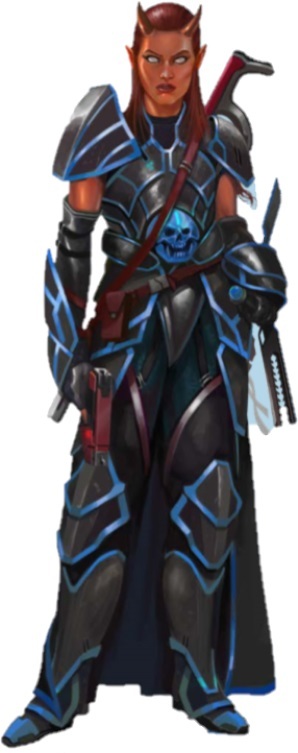
- Horned Humanoid: Most tieflings sport horns as an outward sign of their ancestry.
- Playing with Fire: Many tieflings born of Hell can call forth flames to sear their foes.

Undines are the descendants of humanoids and beings who hail from the Plane of Water. Through they don’t require water to live, undines tend to settle near water and make ideal underwater explorers.
- An Ice Person: Apart from a slight resistance to cold damage, undines can cast Energy Ray at will but only to inflict cold damage and increase any source of cold damage they inflict if they, or their target, is wet enough, such as when swimming or in the middle of a strong enough storm.
